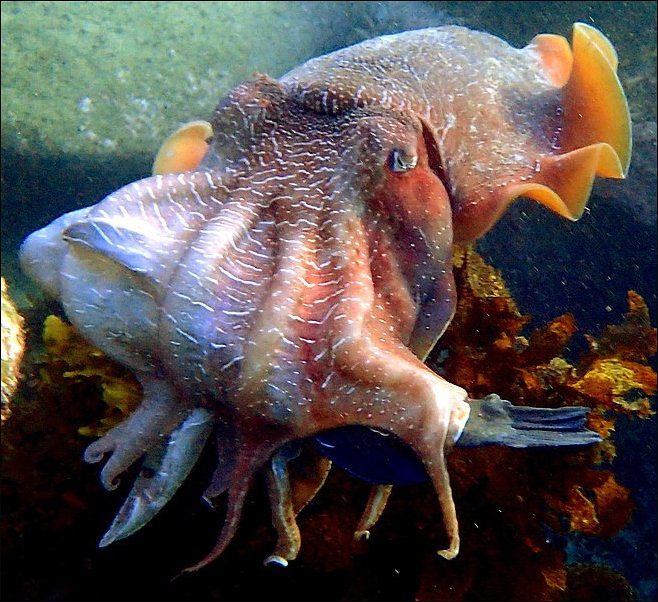
Title: Cuttlefish Chats: Researchers Reveal Intricate Arm Sign Language in the Ocean Depths
In an impressive advancement in marine biology, researchers have found that cuttlefish—already celebrated for their intelligence and ability to camouflage—utilize complex arm movements as a communication method. This discovery not only improves our comprehension of cephalopod behavior but also indicates that their methods of interaction may compete with those of certain vertebrates in terms of intricacy and subtlety.
The study, a joint effort between scientists from the École Normale Supérieure in Paris and the Italian Institute of Technology, details a newly identified “arm wave sign” system employed by two cuttlefish species. The research, published on the preprint server bioRxiv, illuminates how these creatures may use a multi-sensory strategy to convey information to one another.
Arm Movements as a Marine Communication Code
Directed by researchers Sophie Cohen-Bodénès and Peter Neri, the team closely monitored cuttlefish in both natural and controlled settings for several months. Through this detailed observation, they recognized four distinct categories of arm movements, which they referred to as “up,” “side,” “roll,” and “crown” signs. These gestures consist of synchronized, rhythmic fluctuations of the cuttlefish’s arms, frequently accompanied by elaborate color transformations on their skin—features regulated by unique pigment cells known as chromatophores.
Each of these gestures is executed in intentional sequences that can endure for several seconds, creating a type of symbolic language. While the precise meanings of these signals are still being examined, the researchers noted the signs occurring in various situations: during courtship displays, hunting strategies, defensive positions, and sometimes in seemingly spontaneous encounters. This variety implies that arm wave signs may have several functions depending on the social or environmental circumstances.
Visual and Vibrational Communication
What distinguishes this finding is the insight that cuttlefish communication might not be solely visual. By implementing specially designed playback experiments, the researchers revealed that the gestures also produce water vibrations. These mechanical waves, when replayed to other cuttlefish, elicited more vigorous reactions than scrambled or inverted versions—suggesting the existence of specific, understandable information conveyed through the motion-generated vibrations.
Cuttlefish have sensory systems like the lateral line and statocysts, capable of detecting variations in water movement and low-frequency vibrations. These adaptations might enable these animals to “hear” underwater—comparable to the auditory capabilities found in vertebrates.
Interestingly, cuttlefish’s sensitivity to orientation in communication also reflects human social perception. The team discovered that when videos of other cuttlefish executing arm waves were shown upside down, the receiving cuttlefish became less active. This indicates an ability to recognize orientation-dependent social signals, similar to how humans recognize upright faces more easily than those that are inverted.
An Evolutionary Perspective
This discovery enriches the evolutionary narrative of cephalopods. Just as these creatures independently developed camera-like eyes akin to those of mammals and birds, it now seems their communication systems might converge in function—if not in structure—with those of vertebrates. The dual-mode communication—both visual and mechanical—parallels our capacity to synchronize sound and sight for more profound, varied exchanges.
“This could represent a case of convergent evolution, wherein two distinct lineages reach surprisingly similar solutions to communication difficulties,” remarks Dr. Cohen-Bodénès.
Implications for Cephalopod Intelligence and More
Cuttlefish, along with their relatives the octopus and squid, are well-known for their problem-solving skills, camouflage techniques, and complex behaviors—often matching vertebrates in cognitive abilities. The discovery of arm wave communication adds to the accumulating evidence that cephalopods engage in highly advanced, possibly intentional, social signaling.
Grasping this communication system may not only assist in deciphering the social dynamics of cuttlefish but could also provide insights into interspecies communication and sensory processing in other aquatic beings. The team aspires to conduct further research to explore the function and evolution of these gestures and to broaden the study to include other cephalopod species.
Conclusion
The ocean is teeming with unvoiced dialogues, and we now recognize that some include intricate arm movements and soft water currents. As scientists persist in unraveling these marine messages, the unassuming cuttlefish may one day contribute to uncovering more profound mysteries of animal cognition and interspecies communication.
For those intrigued by nature’s hidden dialogues, this research serves as a compelling reminder of how much there remains to discover beneath the waves.
—
Discover more from Wild Science
Subscribe now to receive the latest findings and scientific news delivered directly to your inbox. Stay updated on the marvels of the natural world.